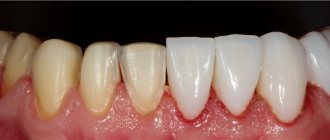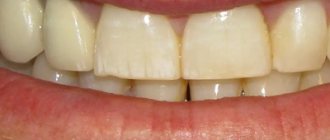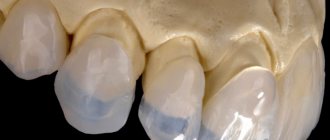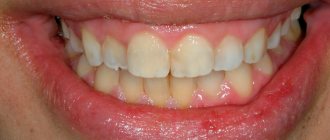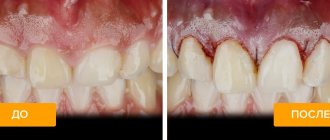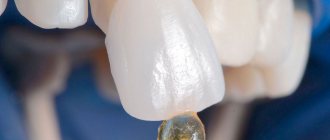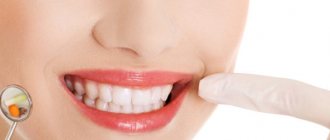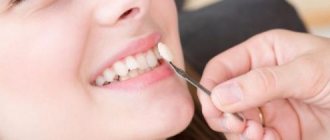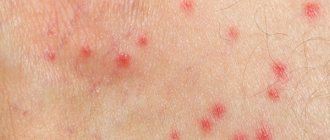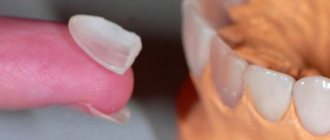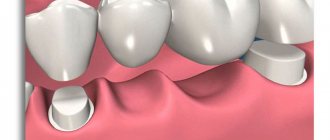A beautiful “Hollywood” smile is the dream of many people. But not many, including Hollywood actors, can boast of it naturally.
To hide imperfections in the front teeth and create a beautiful smile, people are increasingly turning to aesthetic dentistry for help.
Installing veneers is one of the best ways to make your smile perfect today.
Veneers are thin translucent microprosthetic plates that are placed on the front of the teeth to hide visible defects.
Until recently, there were only a few models of dental onlays. And they differed only in material and price. The development of modern technologies has made it possible to bring this field of microprosthetics to a new level, which has expanded the number of ways to restore the attractiveness of a smile.
Veneers
Veneers
Veneers are a common name for onlays that are made from various materials and are installed on the front teeth to visually improve their appearance and prevent early decay.
At one time, they became an advanced method in improving the visual appearance of teeth and an alternative to installing massive crowns or implantation.
Depending on the material from which they are made, there are the following veneers:
- composite;
- ceramic (or porcelain);
- zirconium.
What is their difference?
Composite veneers
They were one of the first to appear on the aesthetic dentistry market. They are mainly made from filling materials and are not much inferior in quality to other linings.
Composite veneers
There are a number of benefits from using these veneers:
- no complete grinding of teeth is required;
- are established in one visit to the doctor;
- It is easier for a composite veneer to choose a natural color and texture that will not differ from other teeth;
- such onlays are installed on one or two teeth for minor defects;
- if you increase the number of layers of composite material, you can achieve higher strength;
- if necessary, these veneers can be easily removed by a dentist;
- relatively low cost.
However, despite the advantages of using such veneers, there are also significant disadvantages:
- Over time, the color of the veneers may change;
- in order to keep the linings in their original form longer, the patient will have to stop eating certain types of products;
- There are not so many shades of the composite, so there is still a possibility that the color of the teeth will be slightly different;
- the quality of manufacturing and installation of composite onlays depends on the professionalism of the dentist and his experience, so there is a risk of getting a poor-quality result;
- the large thickness of the plate itself is about 1 mm, which creates an unnatural appearance when speaking;
- due to the fact that the material does not adhere exactly to the surface of the tooth, there is a possibility of plaque accumulation, and this is fraught with the occurrence of caries and gum inflammation.
- Service life up to 7 years with proper care.
Since the service life of composite veneers is short and the number of disadvantages is large, more and more clinics are abandoning their installations in favor of more modern materials.
Ceramic veneers
Ceramic veneers
The main difference between ceramic veneers and composite ones is that they are made in laboratories after appropriate impressions of the teeth and a panoramic photograph of the jaw have been taken. Therefore, to install them, you must visit your doctor at least twice.
Among the main advantages of ceramics are:
- aesthetic qualities - the color of the overlays is as close as possible to the natural color of tooth enamel;
- high degree of resistance to coloring products;
- durability and long period of use - service life declared by experts is 10 years;
- There is no need for any special care - it is enough to perform basic oral hygiene and visit the dentist once a year for preventive maintenance.
The disadvantage of ceramic veneers is their high price compared to composite ones, which can seriously hit clients’ wallets.
Zirconium veneers
Marielaina Perrone DDS Porcelain Crowns
The basis for the manufacture of such onlays is zirconium dioxide, which is considered advanced in the aesthetic dentistry market. In the manufacture of the zirconium dioxide frame, on which the ceramic material is applied, expensive Western computer technology CAD/CAM is used.
Recently, in addition to crowns and dentures, this material has also been used to make onlays, which have the following advantages:
- super durable material;
- color stability;
- the ability to choose an individual shade according to the Vita scale;
- the minimum thickness of the lining is from 0.3 mm, which makes them almost invisible;
- biocompatibility with teeth, absence of allergic reactions;
- service life - up to 20 years.
However, despite the significant advantages, there are also disadvantages to such veneers:
- high cost - comparable to installing implants;
- the clinic must have special equipment on which veneers are made;
- The doctor must have the necessary qualifications to work with zirconia veneers.
Detailed description of installation technology
Installation of overlays takes place in several stages and takes some time (about 2 weeks):
- Stage 1 – preparatory . If there is a filling on the front side of the tooth, and part of it remains after grinding, the old filling material is replaced with a new one. This is necessary so that the plate holds tightly after gluing.
- Stage 2 – color selection . In order for the veneer to look natural in the mouth, its color should match the adjacent teeth. The shade of the plate is selected according to a special scale.
- Stage 3 – tooth preparation .
The top hard layer is worn down. The grinding depth depends on the thickness of the pad and is usually 0.5 mm. But in a particular case it may be more. To prevent pain from bothering the patient, local anesthesia is used. - Stage 4 – making a cast . An overlay will be made on it in the laboratory.
- Stage 5 – installation of a temporary overlay . The permanent veneer will take 1-2 weeks to be made. All this time, the prepared tooth needs protection from the aggressive environment of the oral cavity, so it is covered with a temporary plastic plate.
- Stage 6 – making veneers . In the laboratory, based on the impressions obtained, a model of the teeth is made, which serves as the basis for the production of permanent onlays. The technology depends on the type of plates chosen and the capabilities of the laboratory of a given clinic.
- Stage 7 – installation of plates .
Veneers are attached to their permanent place using an adhesive cement mass. Before this, a specialist can try different types of special pastes, the color of which matches the colors of the cement. This will allow you to select the cementitious substance in such a way that its shade does not interfere with the aesthetic effect of the installed overlays. Before installation, the inner surface of the lining is processed to give it better adhesion properties. - Stage 8 – polishing the record.
- Stage 9 – recovery and rehabilitation.
After the veneers are installed, the patient can lead a normal lifestyle, following the dentist’s recommendations for proper care of the veneers. After a few days, it is advisable to see a specialist again to check the reaction of the gums to the installed plates.
We will tell you which one is better to insert the front tooth by considering many designs.
In this review, we will find out how to treat stomatitis in children’s mouths, look at the photos.
Your baby is teething, but you doubt it. Here: https://zubovv.ru/detskaya-stomatologia/d-zubi/prorezyivanie-z/vse-simptomyi.html - the symptoms are listed.
Lumineers
Lumineers
A new direction in aesthetic dentistry has recently been the installation of lumineers . They are also called Hollywood teeth veneers. American manufactures and supplies such linings.
The plates are made from high-strength ceramics, the plate thickness of which is only 0.2-0.3 mm.
Installing lumineers, unlike ceramic veneers, has a number of positive aspects:
- before installing ultra-thin veneers, no heavy grinding of the tooth is required; only a minimal layer of enamel is removed;
- since the installation procedure does not require tooth preparation, therefore, it is painless and does not require anesthesia;
- resistance to mechanical loads, do not wear out over time;
- these linings are glued to a special composition insoluble in saliva, which contains a substance - fluoride, which has a beneficial effect on the teeth, and thereby protects against secondary caries;
- the ability to choose the color of the lining identical to the natural color of the patient’s teeth;
- The service life of such veneers is up to 20 years.
Despite the advantages of lumineers, there are also disadvantages:
- since lumineers are produced only in one place - in America, patients have to wait about 2 months before installation;
- The cost of installing one lumineer is several times higher than the cost of a veneer.
But is it still possible in some cases?
All cases are individual, so the final decision can only be made at an appointment with a doctor. It is indeed possible to hide slight crooked teeth with the help of veneers - if it is not associated with an incorrect bite. We are talking literally about 1–2 millimeters. By choosing the shape of the plates, you can level out tooth rotation. If one tooth is slightly pushed back relative to the others, a veneer that is slightly thicker than the others can be installed on it. Also, with the help of veneers it is easy to hide a small diastema.
A slight curvature can be hidden, a very pronounced one cannot.
It must be said that mildly expressed defects in the position of teeth can easily be corrected with the help of aligners in just a few months. You will not have to install braces, and the treatment will be completely invisible to others. If you like the shape and color of your teeth and the enamel has no flaws (fluorosis, stains, darkening), then orthodontic treatment will give an equally attractive result. In addition, there will be no need to grind down healthy teeth.
In any case, if the teeth are positioned incorrectly, it is best not to hide it, but to have it treated by an orthodontist, eliminating the underlying problem. And then move on to aesthetic procedures. If you carry out treatment in this order, the result will be the best possible.
Ultraneers
Ultraneers
They appeared relatively recently and serve as a good alternative to American lumineers. This type of onlay was developed in Russia based on patented ceramics of the IPS E. MAX brand.
Using modern technologies, pressed ceramics are produced from which ultra-thin plates are created - ultraneers.
Pros of ultra training:
- high aesthetics - the color of the lining can be matched exactly to the natural shade of the patient’s teeth;
- It can also be installed on sensitive teeth, since the grinding of the supporting tooth is minimal or not done at all;
- strength is 40% higher than that of ceramic veneers;
- since this is a completely Russian development, the cost does not depend on currency fluctuations and is therefore lower than the cost of lumineers;
- no need to wait several months before installation, since the product is manufactured in Russia;
- service life is about 15 years.
A significant disadvantage of ultranir is their high cost. They are 2 times more expensive than veneers, although they are produced in Russia. However, the cost of ultraneers is 30-40% lower than the cost of American lumineers.
Manufacturing techniques
Ceramic veneers for the lower teeth are made in two ways:
- step-by-step application of several layers of material to the model with further firing of ceramics;
- Using high heat and pressure to instantly cast veneers.
The veneers created using the second method have good strength, which is guaranteed to increase their service life.
Note: there are also zirconium tips. They are made from zirconium dioxide and polished on top with a phosphorus mixture.
Nanoneers
Nanoneers
There is a misconception that nanoeers are a new generation of American lumineers. This is not entirely true.
This veneer design is created in Russian clinics, but from material and technology developed in Switzerland. The ceramics used to make nanoirs contain nanoparticles, which significantly improves the quality of the material.
The similarity with lumineers is that the abutment tooth is not ground down before installation. However, after the onlay is fixed, it must be polished and adjusted to the size of the tooth.
The advantage of this type of overlay is that they are cheaper than ultraneers and lumineers. But at the same time they are not so durable and aesthetically pleasing. In Russia, such prostheses are installed only in some clinics.
Is it always possible to get veneers?
Installation of veneers and lumineers is carried out only on healthy teeth. Therefore, before installing any type of onlays, the patient needs to visit the dentist’s office and undergo a full examination of the oral cavity - to cure caries and get rid of possible problems with the gums. This is necessary so that in the future, when installing veneers, no problems arise, and they do not have to be removed ahead of time.
It must be remembered that, like any medical procedure, the installation of veneers has contraindications:
- the presence of a pronounced malocclusion, which must first be corrected with braces or any other removable denture;
- bruxism - involuntary “grinding” of teeth, which can destroy even a durable denture;
- the absence of more than 50% of the tooth or the presence of a large filling on the surface of the tooth, which will make it difficult to securely fix the onlay on the tooth;
- lack of chewing teeth;
- pathological abrasion of teeth;
- periodontal disease.
As you can see, many contraindications are relative - they, one way or another, can be eliminated by the dentist, after which veneers can be installed.
To avoid any unpleasant moments in connection with the installation of veneers and to make your smile shine again and bring you joy, you need to contact only professionals.
Features of cosmetic restoration on the lower incisors
The lower incisors are the smallest teeth, which, nevertheless, play an important role as a cutting tool when biting food. Therefore, they are susceptible to destruction to no less extent than the upper ones, especially along the cutting edge. They require cosmetic restoration, which has several features:
- The lower incisors often become crowded due to underdevelopment of the lower jaw or displacement of the chewing teeth. This makes it difficult to prepare teeth and install veneers.
- The anatomical proximity of the outlet openings of the sublingual and submandibular salivary glands to the lower incisors causes the deposition of tartar on their surface. Careful removal of stone and restoration of the gingival margin is required.
- During atrophic processes in the periodontium, the roots of the lower incisors quickly become exposed, visually lengthening the teeth. And then the incisors are the first to become loose and fall out. The need to make veneers is explained by their displacement.
To prevent veneers from chipping when biting food, microprostheses for the lower jaw are created with the obligatory overlap of the cutting edge. Overlapping is also necessary to align the cutting edge, which is noticeable when smiling and talking.
Care
Onlays do not require special care, but some requirements must still be observed to ensure the durability of these dental structures:
- hygienic oral care procedures must be carried out twice a day so that the plates do not lose their appearance;
- You should avoid sudden changes in temperature in the oral cavity during meals;
- it is advisable to avoid putting pressure on the teeth on which the plates are installed - biting off very hard food, crunching nuts, candy, etc.;
- try not to abuse drinks that can stain installed structures - strong tea, coffee, rich red juices;
- Visit your dentist twice a year to check the condition of the veneers and their possible correction;
- If the onlay falls off the tooth, save it, the doctor will put it in place.
Gone are the days when a person could be embarrassed about his smile due to defects in his teeth. Now almost any situation can be corrected in an unnoticeable way. Veneers are one of them.
In conclusion, you will find an interesting video from which you will learn a lot of interesting information about this type of fixed dentures:
If you find an error, please select a piece of text and press Ctrl+Enter.
Tags veneers dentures fixed dentures photos
Did you like the article? stay tuned
Our doctors
Clinic Director
Berezin Pavel Nikolaevich
Chief physician
Sakhnova Galina Leonidovna
Therapist
Lizunova Anfisa Pavlovna
all Doctors
Questions and answers
Is it possible to hide or disguise a crooked tooth with a veneer?
Good afternoon Tell me, is it possible to hide/disguise it with a veneer if a tooth is crooked? On my right, the fang goes inside the jaw. I don’t want to get braces, and I can’t afford the money for mouthguards. It seems like the solution is veneers, but I need your preliminary advice.
Hello!
Theoretically, such defects can be corrected by installing veneers. However, only a doctor can answer you for sure based on the results of the examination. Come to our specialists for a free consultation, the doctor will explain to you all the details of veneer prosthetics and write out a treatment plan indicating the cost. Our clinic uses highly aesthetic Empress veneers made from ultra-strong ceramics. For more details and to sign up for a free consultation, please call +. Sincerely, Patient Support Center SIMPLADENT++8 800 333-53-41 Other questions
Contraindications
Not every patient has the opportunity to install dental microprostheses.
It is unacceptable to install onlays on the frontal area of the teeth for people suffering from:
- malocclusion (straight, deep, cross);
- bruxism (the habit of grinding your teeth);
- periodontal disease, periodontitis or worsened gingivitis;
- advanced caries;
- tooth destruction by 50% or more;
- not fully erupted tooth;
- periodontal disease, periodontitis or gingivitis in the acute stage
- absence of more than 7 chewing teeth;
- habit of chewing hard objects with teeth.
People who practice martial arts and boxing need to give up the idea of veneering. The pads are not able to withstand powerful impacts and will constantly deteriorate.
Veneers are the best method to help cope with crooked teeth. By choosing the right specialist, you can quickly install the onlays and enjoy the acquisition of a dazzling smile.
Which method to choose
A specialist will help you decide on the restoration method.
Experts recommend in difficult situations to give preference to installing a vestibular or lingual type brace system. A similar system can also be used to treat children during the formation of the jaw area.
In order to straighten the curvature of the dentition in adults, it is worth giving preference to veneers or mouth guards. Among the main advantages of the veneering technique and wearing aligners, it is worth highlighting the absence of discomfort that occurs while wearing devices.
Each method of teeth straightening is best used in childhood. To carry out one or another alignment technique, you should contact a dental clinic so that a specialist can assess the condition of your teeth and help you decide on the method of correction. When choosing a therapy technique, the dentist is guided by :
- age category of the patient;
- presence of health problems;
- condition of the dentition.
where to go
| Clinic | Address | Price |
| Belgravia Dental Studio | Addresses of branches on the website. T + | From 67,000 rub. |
| Frau Clinic | St. Gilyarovskogo 55 (499) 322-05-18 | From 45,000 rub. |
| MCDI ROOT | Volgogradsky Prospekt 4A +7(800)200-79-50 | From RUR 37,000 |
| Seline | B. Kondratyevsky Lane 7 (499) 444-31-98 | From 38,000 rub. |
| Family dentistry | St. Marshala Rybalko, 2, building 3. (499) 322-22-71 | From 40,000 rub. |
Before making your final choice of clinic, find out more about the doctors. Consider the work “before” and “after”. Make sure consumables are certified. A smile is important.
